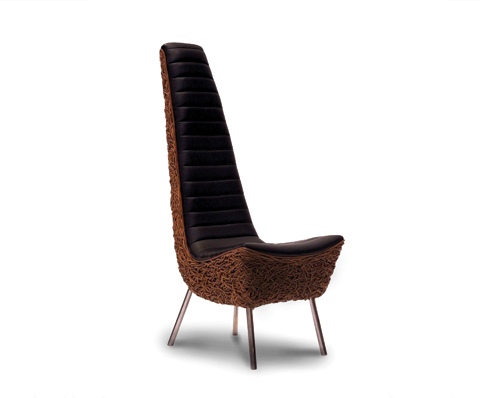An inspired furniture line ideal for creative individuals seeks to enhance domains with pieces that are anything but ordinary.
By Elizabeth Joyce
At the Koji Collection, eco-consciousness is so important it has almost become subconscious, as green thinking is fully integrated into all aspects of the collection
The best in interior design is simultaneously thoughtful and thought provoking; at this level, the process becomes high art. Nesting is the most natural of processes, but also a subject for high-minded debate and a discipline requiring a forward-thinking vision. At the Koji Collection, each piece seems to embody this tangled dichotomy, as ultra-modern designs embrace low, common, and even weed-like materials for the crafting of philosophical works.
Each seat, bed, table, or vase in the Koji Collection is delicately wrought from “nuisance vines,” the underbrush that, when unattended to, can stifle old growth and effectively stunt the progress of a majestic forest, wrapping ancient trees in strangleholds and blocking out precious light. This bramble (the cause of natural, cleansing forest fires) is the primary material for the furniture at the Koji Collection.
These vines grow quickly and are difficult to eradicate, making them the bane of the forest. But using them as furniture translates into fully sustainable (read: ideal) pieces. At the Koji Collection, eco-consciousness is so important it has almost become subconscious, as green thinking is fully integrated into all aspects of the collection. This is an answer to a moral imperative felt by the collection’s owner, Kristian Grant. Grant believes that making modern living “green” is to become part of the solution, rather than the problem-and he has vowed to do so. As such, the water hyacinth vine, rattan, liana, and jute find new purpose, not as choking menaces to ancient growth, but as thoughtful, elegant, and inspiring pieces of home décor.
In making elemental pieces with natural materials with a high-minded purpose, the Koji Collection has attained a balance between our natural selves and our bettered selves, and aims to put symbols of that balance into homes with exciting collections.
Eclectic labels spark the imagination and play with themes from nature, on this planet and beyond. The conceptually charged pieces explore outer space not as a playground for futuristic rockets or manmade splendor, but rather as an extension of our natural world. The space-oriented works look at moonscapes and the natural habitats of space worms and other fantastical creatures. One label, “Space Crab,” dives into this idea headfirst.
The fluidity of form in each piece is celebrated with swooping lines and gentle curves. Negative space, too, plays a role, as singular circular cutouts dot various pieces. Few right angles and many sloping lines combine to create new shapes and furniture that looks more like sculpture.
Some pieces are whimsical, like the “Bug” daybed that has an abundance of curved legs and sprouts two antennae out the front, or the “Space Worm,” a sofa that looks like an oily-black sea cucumber of the future. A bench-style seat called “Universal Magnet” plays with a natural forces theme, while a “Cresent” seat calls to mind images of a waxing moon. Each of these can be found in the “Intergalactic Fusion” line.
Starting with such unique furniture, filling in the accessory gaps might be a challenge. Not just any vase could sit next to your new “Caribou” chairs-minimalist rattan forms whose arms mimic the horns of the northern beast. Yet Koji Collection offers numerous styles for the ultimate solution. One version looks like a tulip bulb that has yet to sprout. Another vase looks like a bulb on fire, while there’s one that resembles an upside-down, sprouting potato. An entire series features variations on a garlic theme.
Though each of these pieces is inspired by naturally occurring, earth-bound flora, with the Koji Collection touch, the effect is certainly out of this world.





















